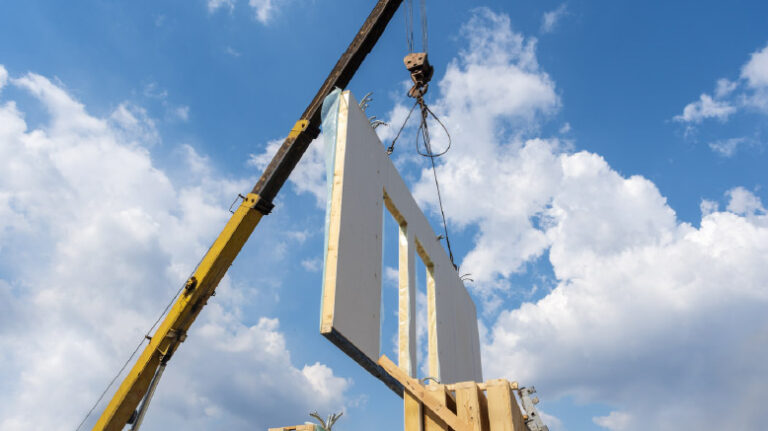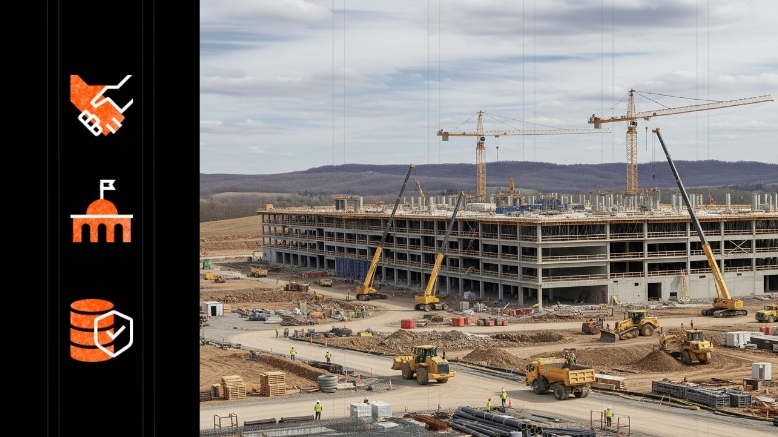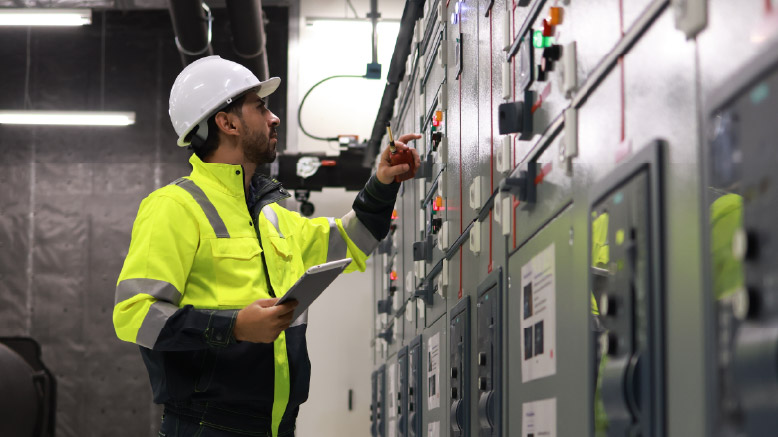— 9 min read
How Modular Construction Can Help Overcome Data Center Labor Shortages

Last Updated Sep 23, 2025

Khaula Mahmood
Enterprise Solution Specialist, Data Centers
Khaula Mahmood is an Enterprise Solution Specialist for Procore, specializing in Data Centers. She has over a decade of experience helping grow major brands like Google, Nike, Starbucks, and Meta. Her broad base of knowledge is the cornerstone of her professional brand and allows her to continue adding recognizable value to the customers she supports, and the sector she is charged with growing. Khaula holds a Bachelor's Degree in Architecture from the Canadian University-Dubai and a Masters in Social Entrepreneurship from the Hult International Business School.
Last Updated Sep 23, 2025

Data center construction is booming — but as the sector grows, the demand for skilled workers to build these highly specialized projects increases. Labor shortages have emerged as a key stumbling block preventing data center owners, developers and general contractors from delivering new facilities fast enough to keep pace with an unprecedented wave of demand.
For many of the firms successfully navigating these labor constraints, modular construction is a central element of their development strategies. Owners and builders can consider incorporating modular or prefabricated data center components — ranging from electrical and cooling systems to architectural elements and entire data halls — which arrive at project sites ready for "plug-and-play" installation, thereby minimizing the need for skilled workers on-site.
This article examines how this modular approach can help overcome labor constraints in data center construction, as well as the barriers limiting the adoption of these solutions in this fast-growing construction sector.
Table of contents
Data centers face a skilled labor shortage.
Building data centers requires a range of workers with highly specialized expertise. These projects don’t just need electricians, mechanical technicians and pipefitters: They require workers in these trades with extensive training and experience with the systems and technologies unique to data centers.
Similarly, these projects don’t just need superintendents and project managers: They require construction management professionals with long data center track records and seasoned veterans who grasp how industry trends and technological advancements will impact a project.
A scarcity of this kind of skilled labor has emerged as one of the most significant constraints limiting the data center industry’s growth. Data center firms consistently identify labor supply as a top reason they are failing to build new facilities quickly enough to meet skyrocketing demand. In a 2024 survey, more than half of data center providers reported being unable to fill open positions, with six in ten reporting difficulty finding qualified candidates.
On top of this, an upcoming wave of retirements is approaching, causing a disproportionate share of the industry’s skilled labor to age out of the workforce. The talent pipelines are not yet in place to replace this generation.
Yet the shortage of skilled labor is already making it difficult for developers and contractors to adhere to construction timelines. Quality control and safety have also suffered as builders struggle to find skilled workers who can competently put data center projects together.
Meanwhile, construction costs have risen as builders bid against each other for talent, fly in skilled contractors and even establish temporary cities to house out-of-town labor for the duration of a project.
The Modular Solution to Labor Management
While major players across the data center ecosystem are pouring resources into workforce development programs to bridge this skills gap, such long-term efforts won’t bear fruit immediately. In the short term, owners and builders are looking for ways to reduce the number of skilled workers needed on-site. Increasingly, that means making data centers modular.
More than ever before, data centers are being constructed from prefabricated, standardized units that are manufactured off-site.
Modular designs allow sophisticated infrastructure like cooling and power management systems that once had to be meticulously constructed on-site by skilled tradesmen to be delivered fully assembled and sometimes integrated into prefabricated structural modules. Deploying these manufactured modular units requires far fewer workers with specialty skill sets than traditional data center construction: Building a data center becomes more like putting together a piece of Ikea furniture and less like crafting a custom dining set from raw lumber.
The adoption of modular design and construction across the data center industry is rapidly gaining momentum. While sales of modular data center solutions totalled just $2.3B in 2020, that market is expected to reach $11.7B by 2027, according to Omdia.
The data center industry’s embrace of modular construction is not only a result of its labor woes. Modular solutions also reduce deployment times and project costs, while centralized off-site manufacturing of data center systems can also result in better quality control and alleviate supply chain problems that continue to plague the sector.
Designing for Modular: Data Center Providers & General Contractors
The world’s largest data center developers and operators — both tech giants like Google and Microsoft and third-party providers like QTS and NTT — are standardizing designs in order to utilize modular solutions and enable off-site construction as they rapidly expand their data center portfolios.
Google, for example, extensively employs modular elements in the design of its self-developed data centers, which typically utilize prefabricated electrical systems, cooling units and server racks. With hyperscalers like Google spending tens of billions of dollars each year on developing new data centers, these tech giants have the buying power to ensure a diverse array of manufacturers are contracted to provide modular systems built to the company’s proprietary standard.
For third-party data center providers and developers, adopting modular solutions can be more challenging. Unlike hyperscalers, who design proprietary data centers tailored to their specific infrastructure, many of these firms must cater to a variety of end-users across their portfolios. Still, the most sophisticated providers are integrating modular designs and off-site prefabrication into the core of their development strategies.
QTS is such a firm, standardizing its "Freedom" data center design across all facility aspects, including architecture and critical equipment. Electrical, cooling and mechanical systems are modularized for deployment in 1.5MW blocks, suitable for facilities up to 72MW. This standardization across QTS's expanding footprint enables extensive offsite construction both for QTS and its tenants.
Manufacturers of data center equipment, meanwhile, are increasingly focused on developing modular systems that can be delivered to data center projects ready to “plug and play.” In many cases, these products can arrive on sites pre-commissioned and factory tested, dramatically reducing skilled labor requirements for installation and deployment
Companies like Schneider Electric, Virtiv and Johnson Controls are among the largest U.S. providers of these modular systems, with prefabricated power skids and cooling systems accounting for the largest share of the market, according to Omdia.
General Contractors' Role in Off-Site Construction
It’s not just data center owners embracing modular solutions — major general contractors tasked with executing a growing number of data center build-outs simultaneously are also getting smart when it comes to utilizing prefabrication and off-site manufacturing strategy to mitigate workforce shortfalls.
With labor stretched thin, and faced with an unprecedented volume of projects scattered across different markets, sophisticated GCs are establishing centralized manufacturing facilities where skilled workers can build complex elements of multiple data centers that can then be delivered to project site and assembled - regardless of whether those components were specifically designed to be modular. This approach dramatically reduces the number of workers with specialty skillsets needed on each individual job site.
A Growing Market For Fully Modular Micro Data Centers
In addition to the use of modular components and off-site construction in the development of large-scale data centers, there is also a growing market for fully modular data center pods — delivered pre-integrated from manufacturers with ready-to-go whitespace and supporting infrastructure for cooling and power.
Sometimes referred to as micro data centers, these shipping container-sized solutions are typically utilized for so-called edge deployments in which a chunk of computing power must be strategically deployed near a concentration of end users - such as on a corporate campus or in a rural population center.
Modular micro data centers represent a growing niche within the data center space, with a number of firms like FlexNode and EdgeAI focused exclusively on these solutions. Demand for these modular pods is expected to grow, with AI adoption driving demand for such edge deployments. Omdia anticipates micro-modular data center sales will reach $3.1B by 2027.
Making data centers modular presents unique challenges.
Although modular construction practices are being utilized across the data center industry, data centers have characteristics that can make implementing these solutions difficult compared to other types of facilities.
The economics of modular only make sense if the modular components are needed at significant scale. Modular design and prefabrication make perfect sense for building homes, for example, because the same manufactured modular products can be used over and over again for years.
With a high degree of standardization across the industry, builders can secure inventory and manufacturers can make capital investments with a reasonable ability to project demand for modular products over a five or ten year period.
Achieving this level of standardization is much more difficult for data centers.
One of the challenges towards standardization is that designs of data center systems can differ greatly between facilities based on factors like end user, location and computing workload. Even a hyperscaler like Google or AWS with a highly standardized data center portfolio will likely have built very different data centers in Phoenix versus Chicago due to vastly disparate cooling needs, water availability and a host of other regional considerations.
Similarly, a multistory data center in an urban environment will have significantly different architectural elements compared to a similar sized deployment on a vast tract of rural land.
Local zoning, design requirements, environmental laws and other regulations also necessitate a degree of customization between sites. The challenge is even greater for third-party providers, as they may need to accommodate a wide range of end-user workloads and design needs across their various facilities.
Adding to the standardization challenge for data centers is the swift evolution of technology, particularly following the explosion of AI computing demand.
IT hardware manufacturers like Nvidia are releasing new processors every few months that require more power per rack and produce more heat than the generation before, often necessitating significant design changes to data centers’ power and cooling infrastructure, architecture and other systems.
Data center builders now routinely contend with multiple major redesigns over the course of a single project. Design uncertainty driven by technological advancement means modular solutions bring with them a degree of financial risk for both owners and equipment vendors, who need to be certain that modular products won’t be obsolete by the time they reach the jobsite.
Free AI in Construction Course with Hugh Seaton
Start learning today with industry expert Hugh Seaton and discover how AI can boost efficiency, reduce risk, and transform your projects.

Overcoming Data Center Building Barriers with Modular Construction
The industry is demonstrating that barriers to modular construction adoption can be overcome.
Indeed, there is little choice but to incorporate some degree of modular construction in order to navigate the significant shortage of skilled labor facing the industry. For both owners and general contractors, overcoming labor constraints requires figuring out how to add modular construction and prefabrication to their development toolkit.
Embracing prefabricated components and off-site assembly, developers can accelerate project timelines, enhance quality control — and, imporantly, reduce on-site labor demands.
While challenges like standardization and rapid technological advancements remain, the momentum behind modular data centers, from hyperscalers to micro data center deployments, suggests a promising path forward.
Was this article helpful?
Thank you for your submission.
0%
0%
You voted that this article was . Was this a mistake? If so, change your vote
Scroll less, learn more about construction.
Subscribe to The Blueprint, Procore’s construction newsletter, to get content from industry experts delivered straight to your inbox.
By clicking this button, you agree to our Privacy Notice and Terms of Service.
Thank you!
You’re signed up to receive The Blueprint newsletter from Procore. You can unsubscribe at any time.
Categories:
Data Center Construction, Resource Management, Tech and Data
Written by

Khaula Mahmood
Enterprise Solution Specialist, Data Centers | Procore Technologies
Khaula Mahmood is an Enterprise Solution Specialist for Procore, specializing in Data Centers. She has over a decade of experience helping grow major brands like Google, Nike, Starbucks, and Meta. Her broad base of knowledge is the cornerstone of her professional brand and allows her to continue adding recognizable value to the customers she supports, and the sector she is charged with growing. Khaula holds a Bachelor's Degree in Architecture from the Canadian University-Dubai and a Masters in Social Entrepreneurship from the Hult International Business School.
View profileExplore more helpful resources

Building Intelligence: How AI & Data Are Rewiring Construction for the Digital Age
As data center construction surges to meet the demands of AI, cloud computing, weekend streaming binges and real-time digital services, the pressure being put on builders by owners has reached...

Power, Politics & Permits: The External Forces Shaping Data Center Development
As the need for digital infrastructure accelerates, data centers have become essential to powering the world’s digital economy. Yet, behind every hyperscale facility is a complex web of external forces...

The New Frontier: How Data Centers Are Pushing the Limits of Construction
The digital world never sleeps — and as such, neither can the infrastructure powering it. As demand for cloud services, artificial intelligence and streaming data continues to surge, data centers...

The Top 5 MEP Challenges of Data Centers
Data centers are unique builds that come with unique challenges. MEP contractors stepping up to build data centers are sure to encounter the complexity of systems and the demands of scalability,...
Free Tools
Calculators
Use our calculators to estimate the cost of construction materials for your next project.
Templates
Find a template to help you with your construction project tasks.
Material Price Tracker
Get the latest U.S. retail prices and view historical trends for common building materials.
Glossary
Explore key terms and phrases used in the industry.
